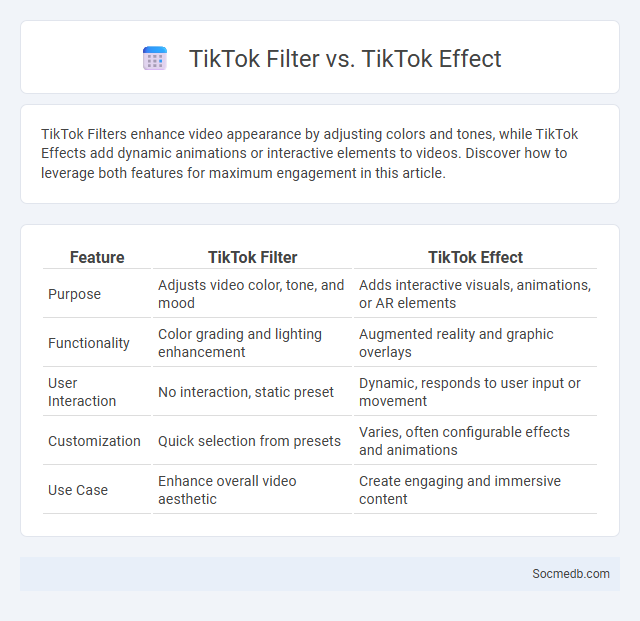
Photo illustration: TikTok Filter vs TikTok Effect
TikTok Filters enhance video appearance by adjusting colors and tones, while TikTok Effects add dynamic animations or interactive elements to videos. Discover how to leverage both features for maximum engagement in this article.
Table of Comparison
| Feature | TikTok Filter | TikTok Effect |
|---|---|---|
| Purpose | Adjusts video color, tone, and mood | Adds interactive visuals, animations, or AR elements |
| Functionality | Color grading and lighting enhancement | Augmented reality and graphic overlays |
| User Interaction | No interaction, static preset | Dynamic, responds to user input or movement |
| Customization | Quick selection from presets | Varies, often configurable effects and animations |
| Use Case | Enhance overall video aesthetic | Create engaging and immersive content |
Understanding TikTok Filters: Definition and Purpose
TikTok filters are digital effects applied to videos and photos that enhance visual appeal and creativity by altering colors, lighting, or adding animations. These filters serve the purpose of engaging viewers and helping content creators express unique styles or moods. Understanding how to use TikTok filters effectively can boost your content's visibility and increase audience interaction on the platform.
What Are TikTok Effects?
TikTok effects are creative filters and visual enhancements that transform your videos by adding animations, augmented reality features, or dynamic backgrounds. These effects use advanced technology such as facial recognition and motion tracking to make your content more engaging and interactive. You can explore a vast library of TikTok effects to customize your videos and boost your audience's engagement.
Key Differences Between Filters and Effects on TikTok
Filters on TikTok primarily alter the color tone, lighting, and overall mood of videos by applying preset adjustments to hue, saturation, and contrast. Effects, in contrast, introduce interactive or augmented reality features such as animations, face modifications, and 3D objects that respond to user movements or facial expressions. While filters enhance the visual atmosphere subtly, effects transform content by adding dynamic and visually engaging elements that significantly change the video's appearance and interactivity.
Types of TikTok Filters Used by Creators
TikTok creators commonly use beauty filters to enhance facial features, AR effects to add interactive elements, and color correction filters to adjust mood and tone. Popular filters like "Vintage," "Glow Up," and "Comic" help your content stand out by creating unique visual styles. Understanding these types enables creators to optimize engagement and tailor videos to specific audience preferences.
Popular TikTok Effects Trending in 2024
Popular TikTok effects trending in 2024 include dynamic AR filters like the Neon Glow, which enhances your videos with vibrant lighting effects, and the Retro VHS effect that adds nostalgic charm with grainy textures and glitch transitions. AI-powered transformation filters are also gaining traction, allowing you to seamlessly morph faces or change backgrounds in real-time for creative storytelling. These cutting-edge effects boost engagement and help your content stand out across TikTok's highly competitive platform.
How to Apply Filters vs. Effects in TikTok Videos
Applying filters on TikTok videos enhances overall color tone and mood, offering predefined adjustments like vintage, black-and-white, or vibrant looks. Effects, on the other hand, introduce interactive or animated elements such as augmented reality masks, visual distortions, or dynamic stickers that respond to movement or sound. To apply filters, select the filter option before or after recording, while effects require tapping the effects icon to browse and apply real-time or post-recording enhancements.
Creative Uses: Filters vs. Effects in Viral Content
Creative uses of social media filters versus effects play a crucial role in crafting viral content by enhancing visual appeal and user engagement. Filters subtly adjust colors and tones, creating a consistent aesthetic that resonates with niche communities, while effects introduce dynamic elements like animations or augmented reality, capturing attention through novelty and interaction. Your choice between filters and effects can significantly influence content virality by appealing to emotional triggers and encouraging sharing across platforms.
User Experience: Visual Impact of Filters and Effects
Filters and effects significantly enhance user experience on social media by transforming ordinary photos into visually striking content that captures attention. The strategic use of color correction, augmented reality lenses, and dynamic overlays increases engagement metrics such as likes, shares, and comments. Optimizing visual impact through these tools drives platform loyalty and continuous user interaction.
Third-Party Effects vs Native TikTok Effects
Third-party effects on social media platforms like TikTok offer diverse filters and augmented reality experiences developed externally to enhance user creativity and engagement. Native TikTok effects, created in-house, provide seamless integration with the app's features and often align closely with trending challenges and popular content styles. The choice between third-party and native effects impacts user interaction, content originality, and the platform's ecosystem dynamics.
Choosing the Right Enhancement: Filter or Effect?
Selecting the right social media enhancement depends on your content goals and audience engagement. Filters subtly adjust color tones and lighting to create a consistent aesthetic, while effects introduce dynamic elements like animations or overlays that capture attention. Your choice should align with your brand identity and the emotion you want to evoke in your followers.
 socmedb.com
socmedb.com